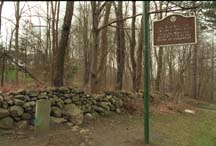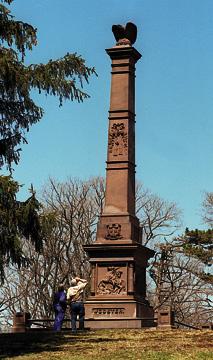
|
Gen. David Wooster: A Largely Forgotten Hero Of The Revolution By Paul Locher, |
![]()

|
Gen. David Wooster: A Largely Forgotten Hero Of The Revolution By Paul Locher, |
![]()
 |
| A sign and a monument on Route 116 (North Salem Road), just a few yards south of its intersection with Tackora Trail, mark the spot where General David Wooster fell, mortally wounded, during the Battle of Ridgefield in 1777. |

|
"Of his country Wooster said, `My life has ever been devoted to her service from my youth up, though never before in a cause like this—a cause for which I would most cheerfully risk and lay down my life.'"

The file for this page was adapted from the one that Janet N. Welty designed for the Wooster-Wayne Chapter of the D.A.R. of Wooster, Ohio (Wayne County). The inspiration for my design came from the companion page for General "Mad Anthony" Wayne. Both pages can be accessed from the Wooster-Wayne D.A.R. home page, if one follows first the link to Chapter History. From the page on Chapter History one can go directly to the General Wooster file by following the link to General Wooster
Paul Locher, the original author of the work is a staff writer for the Daily Record, which is published in Wooster, Ohio.
Two of the pictures came from articles which were published in Danbury, Connecticut by The News-Times. The picture of the site where Wooster was mortally wounded was from an article published just prior to Independence Day in 1997. The picture of the Wooster Monument was from an article dated April 16, 1996. Another view of the Wooster Monument can be found in an article dated April 29, 1996.
Several more files containing information about general David Wooster can be found on my Wooster and Jennings Genealogy Page.

